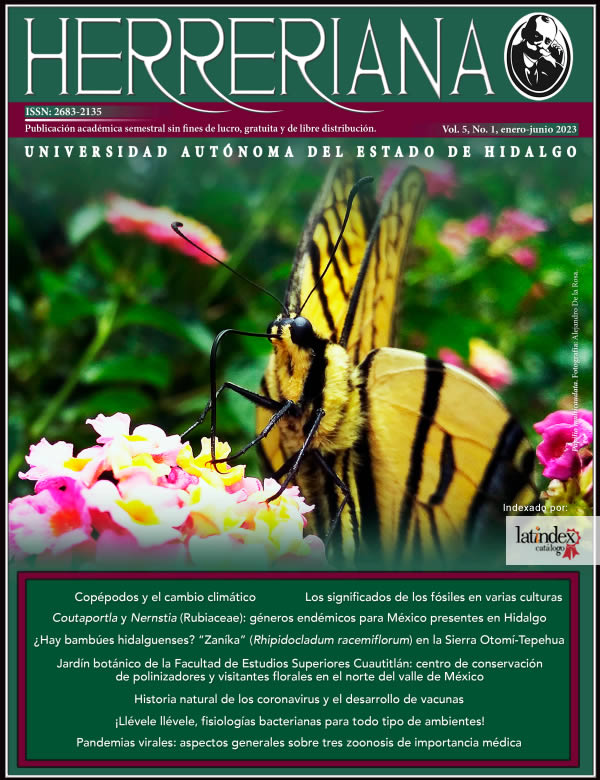The meaning of fossils in different cultures
DOI:
https://doi.org/10.29057/h.v5i1.8621Keywords:
Geomythology, ethnopaleontology, cultural paleontology, popular paleontology, paleontological folkloreAbstract
Throughout history, fossils have not only been of interest to humans by their scientific value, but have also been regarded as mystic and magic objects. This information, beyond being anecdotal, can be considered as a resource for expanding the study of fossils and their applications. This information can be considered as a part of the cultural heritage; therefore, several disciplines and approaches have been proposed to analyze and systematize this knowledge.
Downloads
Publication Facts
Reviewer profiles N/A
Author statements
Indexed in
- Academic society
- N/A
- Publisher
- Universidad Autónoma del Estado de Hidalgo
References
Astudillo Pombo, H. 2010. Paleontología cultural y Etnopaleontología. Dos nuevos enfoques sobre el registro fósil. Enseñanza de las Ciencias de la Tierra, 18 (3): 284-297.
Barbosa Moura, G.J. y Albuquerque, U.P. 2012. The First Report on the Medicinal Use of Fossils in Latin America. Evidence-Based Complementary and Alternative Medicine, ID 691717. Recuperado de https://doi.org/10.1155/2012/691717
Bernal Díaz del Castillo. 1999. Historia verdadera de la conquista de la Nueva España. Editorial Porrúa, México, 701 pp.
Corona-M., E. 2021. Los fósiles como patrimonio natural y cultural. Arqueología Mexicana, XXVIII (170): 30-33.
Goemaere, E., Millier, C., Declercq, P.Y., Fronteau, G. y Dreesen, R. 2021. Legends of the Ardennes Massif, a Cross-Border Intangible Geo-cultural Heritage (Belgium, Luxemburg, France, Germany). Geoheritage, 13: 1-28. Recuperado de https://link.springer.com/article/10.1007/s12371-021-00549-9
González-Rodríguez, K.A., Espinosa-Arrubarrena, L. y Durán-Aguilar, F.R. 2015. Los fósiles marinos de México y los rostros ocultos: una reflexión sobre el significado de la Paleontología y los hombres y las mujeres que están detrás de sus descubrimientos. En: Cuevas-Cardona, C., y González-Rodríguez, K.A. (eds.). Los rostros ocultos de la ciencia. Universidad Autónoma del Estado de Hidalgo, Pachuca, pp. 41-70.
Le Loeuff, J., Laojumpon, C., Suteethorn, S. y Suteethorn, V. 2012. Magic fossils–on the use of Triassic coprolites as talismans and medicine in South East Asia. En: Royo-Torres, R., Gascó, F. y Alcalá, L. (coords.). 10th Annual Meeting of the European Association of Vertebrate Palaeontologists. Teruel, España, pp. 123-125.
Mayor, A. 2002. El secreto de las ánforas: lo que los griegos y los romanos sabían de la prehistoria. Grijalbo, Barcelona. 429 pp.
Mayor, A. 2004. Geomythology. En: Selley, R., Cocks, R. y Palmer, I. (eds.). Enclopedia of Geology. Elsevier. Recuperado de https://web.stanford.edu/dept/HPS/MayorGeomythology.pdf
Mayor, A. 2005. Fossil legends of the first Americans. Princeton, N.J. Princeton University Press. 488 pp.
Moura, G.J., y Albuqerque, U.P. 2012. The first report on the medicinal use of fossils in Latin America. Evidence-based complementary and alternative medicine, (2012):691717. Recuperado de https://www.ncbi.nlm.nih.gov/pmc/articles/PMC3182628/
van der Geer, A. y Dermitzakis, M. 2008. Fossils in pharmacy: from “snake eggs” to “Saint’s bones”; an overview. Hellenic Journal of Geosciences, (45): 323-332.
Vitaliano, D.B. 1968. Geomythology. The impact of gologic events on history and legend with special reference to Atlantis. Journal of the Folklore Institute, 5 (1): 5-30.
Xing, L., Mayor, A., Chen, Y., Harris, J.D. y Burns, M.E. 2011. The folklore of dinosaur trackways in China: Impact on Paleontology. Ichnos, 1(8): 213-220.


















